I considered opening this month’s column with Thoreau’s quote about men becoming the tools of their tools, but that seemed way too pompous (besides I’m not really sure what it means). So, the axiom, “If the only tool you have is a hammer, you tend to see every problem as a nail” is probably a better fit for the topic “fishing tools every fisherman should have.”
Today’s anglers arguably live in a golden age of sport fishing, at least when it comes to boats, motors, and equipment, particularly such “must haves” as mind-blowing, computerized electronics. Fishing tools haven’t really changed all that much relative to reels and rods, but they remain indispensable nonetheless when releasing fish. To that end, we’ve become much more conscientious about the benefits of the practice. Some species require release—billfish and bull red drum are two that leap to mind—while others we let go because we want to do our part to ensure a quality fishery.
Here’s an overview of some key tools I think every angler ought to have with them every time they hit the fresh or salt water.
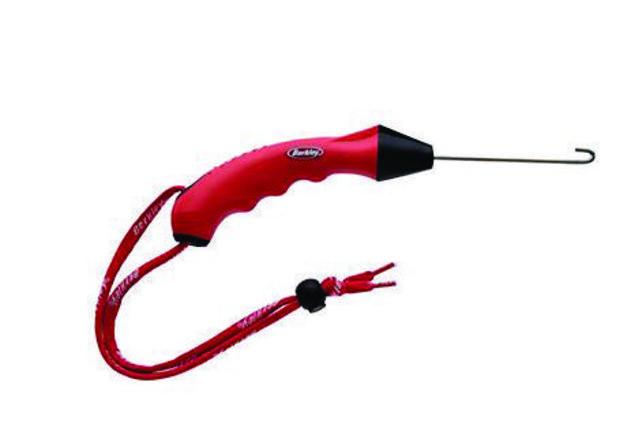 Dehookers
Dehookers
Every angler needs a dehooker. No, I don’t mean a rehab program a certain former New York governor may or may not have completed to lessen his national embarrassment. I’m talking about getting the hook out of the fish’s mouth quickly and easily, people, so focus.
I’ve seen, even made myself, different dehookers. You should have both a J-Hook style as well as a deep-throat dehooker, the second being a pigtail curl design that allows you to remove a hook stuck deep in the fish’s gullet. Berkley, ARC, and Cuda all make good dehookers. For most Chesapeake sportfish, pick one that can handle hook sizes ranging from #1 to 8/0. Dehookers aid in fish survival while avoiding nicks to your fingers and hands. For panfish and perch you’ll want to step down a size or two.
I prefer dehookers with a “T” handle, at least 16 inches long. Choose one constructed of durable stainless steel (304L-316th grade). Those made with titanium components are hard to beat, but overkill in my opinion. But hey, if that’s how you roll, it’s your money. For the offshore gang who tangle with pelagics such as billfish, ARC’s six-foot Big Game release dehooker is ideal. Built from anodized, aircraft aluminum tubing, it has a 5/16-inch diameter pigtail curl made of durable 304L-316th grade stainless steel. You not only get your expensive lure back but it also allows for a fast and safe release.
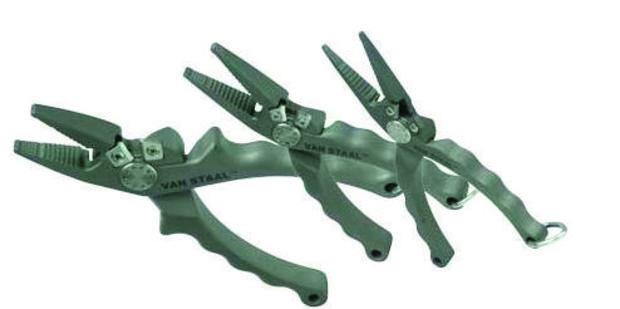 Pliers
Pliers
No fishermen should ever leave the dock without their pliers. They range from the basic hardware-store special to the mid-range ($50 and under, from Berkely and Calcutta) to the ultra-high-end set that are as much works of art as tools. Famous reel makers such as Van Staal, Abel, and Alutecnos offer them. Go with aluminum (6000 series), stainless steel (440C grade), and titanium. Anything else, and you’re wasting your money.
Make sure your pliers have a comfortable and non-slip grip. I prefer plier handles that are curved and rubber coated. You also want a built-in cutter that will snip mono or braided line. Several outdoor retailers offer an affordable plier kit, some of which include leader nippers, cutting pliers, and needle-nose pliers.
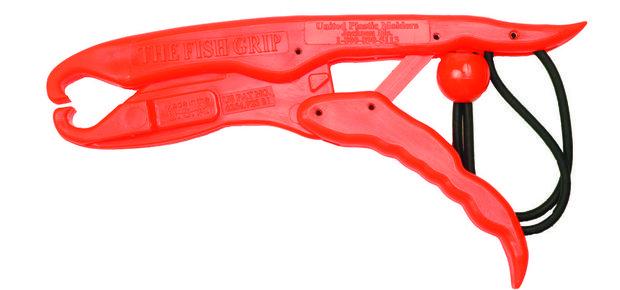 Fish Lip Grippers
Fish Lip Grippers
Control the head, control the fish; so goes the advice in fish fighting. Same holds true for positioning that trophy for a quick photo before release. Over the years, Boga-Grip’s high-quality fish lipper tool has been well worth the money I spent on it. I have the 30- and 60-pound versions, and both feature a patented design that makes weighing your catch easier.
There are other more economical models, including Rapala’s Fish Gripper and Berkley eight-inch Pistol Lip Grip. Both allow for one-handed quick-release of fish. Corrosion-resistant metal construction holds up well to Bay conditions, and like the Boga, safely keeps your digits out of the maw of snippy bluefish or toothy game fish. A good lipper tool also allows you to remove the hook more easily, especially if you’re casting lures with treble hooks. Lip grippers come in digital or mechanical scales versions—I prefer one with a spring-loaded mechanical scale. Clean your metal lippers with soap and fresh water thoroughly after each trip and oil lightly at least once a season.
If a higher end ripper isn’t in your budget, or you don’t need a scale (see sidebar), for less than $20 you can opt for one of the polyethylene types on the market. The Fish Grip is popular among kayak anglers as well as small boat and shore fishermen. It locks easily so you can safely land and release game fish. Also, it can handle up to 200 pounds, floats, and comes in hi-vis colors.
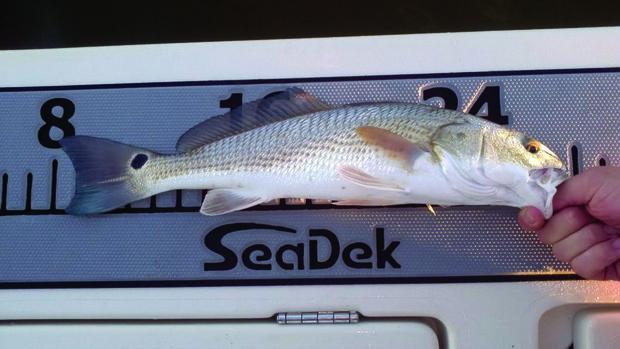 Measuring Stick
Measuring Stick
Fish size limits vary from season to season, sometimes changing within a season, as well as from state to state. It’s your ethical responsibility to know the rules, so a measuring stick or cradle tool made of durable yet lightweight materials takes the guess work out. If they float, all the better. Homemade versions are not uncommon, and some I’ve seen are production models such as Hawg Trough and Yak Gear’s Floating Fish Ruler come in handy to making sure you’re compliant with the law or tournament rules.
Some Google time unveiled to me SeaDek’s 36-inch fish ruler, constructed from six-millimeter, closed-cell EVA material. That’s the same stuff they use for their deck pads. The cool thing about the ruler, according to the manufacturers specs, is that when you place the ruler on the gunnel, it should stay put while measuring your catch, thanks to its non-skid bottom.
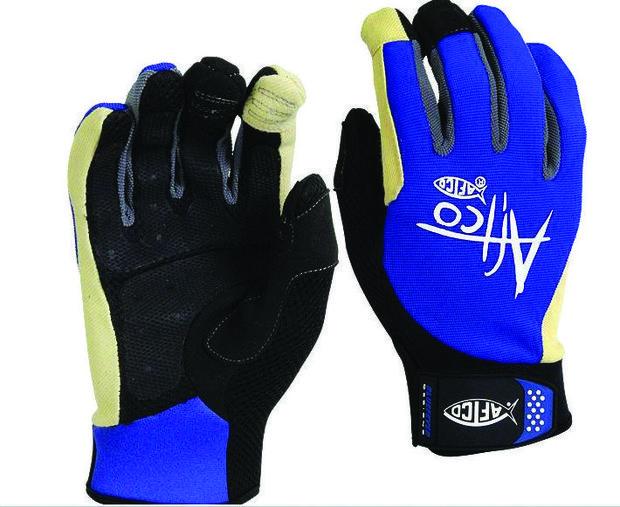 Gloves
Gloves
I’m a big believer in gloves when handling fish for two reasons: to prevent nicks and cuts from fish teeth, spines, and gill plates and to minimize the loss of a fish’s protective slime. To the first point, not trying to be a downer, but scientists estimate that as many as 70 percent of Chesapeake stripers have mycobacteriosis. While not a crisis to fishermen, it can be transmitted to people with open cuts or sores, resulting in “fish handler’s disease” that can turn serious if left untreated. I always wash up and apply anti-bacterial hand sanitizer after handling fish.
Survey a dozen fishermen at any marina about their glove preference, and you’re bound to get 12 different responses. As do reels and rods, fishing gloves run the price gamut. Some anglers are just fine with cotton or canvas gloves purchased from building supply stores, while others prefer higher end gloves such as AFTCO’s Release or Lindy’s Fish Gloves, both of which are specifically designed for the salt and made with materials that improves grip while protecting against puncture.
Local company Pax River Products created the Fishoff Glove, made of sturdy cotton with a coating of rubber latex. The innovative hook-and-loop attachment system keeps them handy when the bite is on and you’re handling fish.
Forgot Your Scale?
You've landed a monster fish, a personal best, but you forgot your scale and don't want to kill it. A simple soft tailor's tape and IGFA's Fish Weight Formula will tell you its weight:
(Girth x Girth x Length)/800 = Weight in Pounds
by Captain Chris D. Dollar Dehookers
Every angler needs a dehooker. No, I don’t mean a rehab program a certain former New York governor may or may not have completed to lessen his national embarrassment. I’m talking about getting the hook out of the fish’s mouth quickly and easily, people, so focus.
I’ve seen, even made myself, different dehookers. You should have both a J-Hook style as well as a deep-throat dehooker, the second being a pigtail curl design that allows you to remove a hook stuck deep in the fish’s gullet. Berkley, ARC, and Cuda all make good dehookers. For most Chesapeake sportfish, pick one that can handle hook sizes ranging from #1 to 8/0. Dehookers aid in fish survival while avoiding nicks to your fingers and hands. For panfish and perch you’ll want to step down a size or two.
I prefer dehookers with a “T” handle, at least 16 inches long. Choose one constructed of durable stainless steel (304L-316th grade). Those made with titanium components are hard to beat, but overkill in my opinion. But hey, if that’s how you roll, it’s your money. For the offshore gang who tangle with pelagics such as billfish, ARC’s six-foot Big Game release dehooker is ideal. Built from anodized, aircraft aluminum tubing, it has a 5/16-inch diameter pigtail curl made of durable 304L-316th grade stainless steel. You not only get your expensive lure back but it also allows for a fast and safe release.
Dehookers
Every angler needs a dehooker. No, I don’t mean a rehab program a certain former New York governor may or may not have completed to lessen his national embarrassment. I’m talking about getting the hook out of the fish’s mouth quickly and easily, people, so focus.
I’ve seen, even made myself, different dehookers. You should have both a J-Hook style as well as a deep-throat dehooker, the second being a pigtail curl design that allows you to remove a hook stuck deep in the fish’s gullet. Berkley, ARC, and Cuda all make good dehookers. For most Chesapeake sportfish, pick one that can handle hook sizes ranging from #1 to 8/0. Dehookers aid in fish survival while avoiding nicks to your fingers and hands. For panfish and perch you’ll want to step down a size or two.
I prefer dehookers with a “T” handle, at least 16 inches long. Choose one constructed of durable stainless steel (304L-316th grade). Those made with titanium components are hard to beat, but overkill in my opinion. But hey, if that’s how you roll, it’s your money. For the offshore gang who tangle with pelagics such as billfish, ARC’s six-foot Big Game release dehooker is ideal. Built from anodized, aircraft aluminum tubing, it has a 5/16-inch diameter pigtail curl made of durable 304L-316th grade stainless steel. You not only get your expensive lure back but it also allows for a fast and safe release.
 Pliers
No fishermen should ever leave the dock without their pliers. They range from the basic hardware-store special to the mid-range ($50 and under, from Berkely and Calcutta) to the ultra-high-end set that are as much works of art as tools. Famous reel makers such as Van Staal, Abel, and Alutecnos offer them. Go with aluminum (6000 series), stainless steel (440C grade), and titanium. Anything else, and you’re wasting your money.
Make sure your pliers have a comfortable and non-slip grip. I prefer plier handles that are curved and rubber coated. You also want a built-in cutter that will snip mono or braided line. Several outdoor retailers offer an affordable plier kit, some of which include leader nippers, cutting pliers, and needle-nose pliers.
Pliers
No fishermen should ever leave the dock without their pliers. They range from the basic hardware-store special to the mid-range ($50 and under, from Berkely and Calcutta) to the ultra-high-end set that are as much works of art as tools. Famous reel makers such as Van Staal, Abel, and Alutecnos offer them. Go with aluminum (6000 series), stainless steel (440C grade), and titanium. Anything else, and you’re wasting your money.
Make sure your pliers have a comfortable and non-slip grip. I prefer plier handles that are curved and rubber coated. You also want a built-in cutter that will snip mono or braided line. Several outdoor retailers offer an affordable plier kit, some of which include leader nippers, cutting pliers, and needle-nose pliers.
 Fish Lip Grippers
Control the head, control the fish; so goes the advice in fish fighting. Same holds true for positioning that trophy for a quick photo before release. Over the years, Boga-Grip’s high-quality fish lipper tool has been well worth the money I spent on it. I have the 30- and 60-pound versions, and both feature a patented design that makes weighing your catch easier.
There are other more economical models, including Rapala’s Fish Gripper and Berkley eight-inch Pistol Lip Grip. Both allow for one-handed quick-release of fish. Corrosion-resistant metal construction holds up well to Bay conditions, and like the Boga, safely keeps your digits out of the maw of snippy bluefish or toothy game fish. A good lipper tool also allows you to remove the hook more easily, especially if you’re casting lures with treble hooks. Lip grippers come in digital or mechanical scales versions—I prefer one with a spring-loaded mechanical scale. Clean your metal lippers with soap and fresh water thoroughly after each trip and oil lightly at least once a season.
If a higher end ripper isn’t in your budget, or you don’t need a scale (see sidebar), for less than $20 you can opt for one of the polyethylene types on the market. The Fish Grip is popular among kayak anglers as well as small boat and shore fishermen. It locks easily so you can safely land and release game fish. Also, it can handle up to 200 pounds, floats, and comes in hi-vis colors.
Fish Lip Grippers
Control the head, control the fish; so goes the advice in fish fighting. Same holds true for positioning that trophy for a quick photo before release. Over the years, Boga-Grip’s high-quality fish lipper tool has been well worth the money I spent on it. I have the 30- and 60-pound versions, and both feature a patented design that makes weighing your catch easier.
There are other more economical models, including Rapala’s Fish Gripper and Berkley eight-inch Pistol Lip Grip. Both allow for one-handed quick-release of fish. Corrosion-resistant metal construction holds up well to Bay conditions, and like the Boga, safely keeps your digits out of the maw of snippy bluefish or toothy game fish. A good lipper tool also allows you to remove the hook more easily, especially if you’re casting lures with treble hooks. Lip grippers come in digital or mechanical scales versions—I prefer one with a spring-loaded mechanical scale. Clean your metal lippers with soap and fresh water thoroughly after each trip and oil lightly at least once a season.
If a higher end ripper isn’t in your budget, or you don’t need a scale (see sidebar), for less than $20 you can opt for one of the polyethylene types on the market. The Fish Grip is popular among kayak anglers as well as small boat and shore fishermen. It locks easily so you can safely land and release game fish. Also, it can handle up to 200 pounds, floats, and comes in hi-vis colors.
 Measuring Stick
Fish size limits vary from season to season, sometimes changing within a season, as well as from state to state. It’s your ethical responsibility to know the rules, so a measuring stick or cradle tool made of durable yet lightweight materials takes the guess work out. If they float, all the better. Homemade versions are not uncommon, and some I’ve seen are production models such as Hawg Trough and Yak Gear’s Floating Fish Ruler come in handy to making sure you’re compliant with the law or tournament rules.
Some Google time unveiled to me SeaDek’s 36-inch fish ruler, constructed from six-millimeter, closed-cell EVA material. That’s the same stuff they use for their deck pads. The cool thing about the ruler, according to the manufacturers specs, is that when you place the ruler on the gunnel, it should stay put while measuring your catch, thanks to its non-skid bottom.
Measuring Stick
Fish size limits vary from season to season, sometimes changing within a season, as well as from state to state. It’s your ethical responsibility to know the rules, so a measuring stick or cradle tool made of durable yet lightweight materials takes the guess work out. If they float, all the better. Homemade versions are not uncommon, and some I’ve seen are production models such as Hawg Trough and Yak Gear’s Floating Fish Ruler come in handy to making sure you’re compliant with the law or tournament rules.
Some Google time unveiled to me SeaDek’s 36-inch fish ruler, constructed from six-millimeter, closed-cell EVA material. That’s the same stuff they use for their deck pads. The cool thing about the ruler, according to the manufacturers specs, is that when you place the ruler on the gunnel, it should stay put while measuring your catch, thanks to its non-skid bottom.
 Gloves
I’m a big believer in gloves when handling fish for two reasons: to prevent nicks and cuts from fish teeth, spines, and gill plates and to minimize the loss of a fish’s protective slime. To the first point, not trying to be a downer, but scientists estimate that as many as 70 percent of Chesapeake stripers have mycobacteriosis. While not a crisis to fishermen, it can be transmitted to people with open cuts or sores, resulting in “fish handler’s disease” that can turn serious if left untreated. I always wash up and apply anti-bacterial hand sanitizer after handling fish.
Survey a dozen fishermen at any marina about their glove preference, and you’re bound to get 12 different responses. As do reels and rods, fishing gloves run the price gamut. Some anglers are just fine with cotton or canvas gloves purchased from building supply stores, while others prefer higher end gloves such as AFTCO’s Release or Lindy’s Fish Gloves, both of which are specifically designed for the salt and made with materials that improves grip while protecting against puncture.
Local company Pax River Products created the Fishoff Glove, made of sturdy cotton with a coating of rubber latex. The innovative hook-and-loop attachment system keeps them handy when the bite is on and you’re handling fish.
Forgot Your Scale?
You've landed a monster fish, a personal best, but you forgot your scale and don't want to kill it. A simple soft tailor's tape and IGFA's Fish Weight Formula will tell you its weight:
(Girth x Girth x Length)/800 = Weight in Pounds
by Captain Chris D. Dollar
Gloves
I’m a big believer in gloves when handling fish for two reasons: to prevent nicks and cuts from fish teeth, spines, and gill plates and to minimize the loss of a fish’s protective slime. To the first point, not trying to be a downer, but scientists estimate that as many as 70 percent of Chesapeake stripers have mycobacteriosis. While not a crisis to fishermen, it can be transmitted to people with open cuts or sores, resulting in “fish handler’s disease” that can turn serious if left untreated. I always wash up and apply anti-bacterial hand sanitizer after handling fish.
Survey a dozen fishermen at any marina about their glove preference, and you’re bound to get 12 different responses. As do reels and rods, fishing gloves run the price gamut. Some anglers are just fine with cotton or canvas gloves purchased from building supply stores, while others prefer higher end gloves such as AFTCO’s Release or Lindy’s Fish Gloves, both of which are specifically designed for the salt and made with materials that improves grip while protecting against puncture.
Local company Pax River Products created the Fishoff Glove, made of sturdy cotton with a coating of rubber latex. The innovative hook-and-loop attachment system keeps them handy when the bite is on and you’re handling fish.
Forgot Your Scale?
You've landed a monster fish, a personal best, but you forgot your scale and don't want to kill it. A simple soft tailor's tape and IGFA's Fish Weight Formula will tell you its weight:
(Girth x Girth x Length)/800 = Weight in Pounds
by Captain Chris D. Dollar